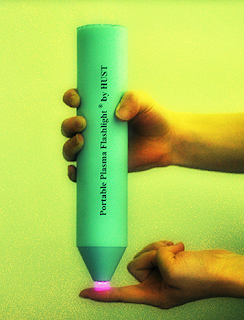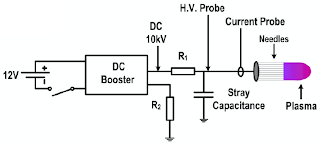Handheld Plasma Flashlight Rids Skin of Pathogens
April 6, 2012
Ray Kurzweil
Portable plasma flashlight (credit: X. Pei et al./IoP)
Imagine a handheld, battery-powered plasma-producing device that can rid skin of bacteria in an instant — no soap and water required.
It could be used in ambulance emergency calls, natural disaster sites, military combat operations, and wherever treatment is required in remote locations.
It’s called a “plasma flashlight.”
In an experiment, the plasma flashlight effectively inactivated a thick biofilm with 17 different layers of one of the most antibiotic- and heat-resistant bacteria, Enterococcus faecalis — which often infects root canals during dental treatments.
The plasma penetrated deep into the very bottom of the layers to kill the bacteria in five minutes. For individual bacteria, the inactivation time could be just tens of seconds.
How it works
Although the exact mechanism behind the anti-bacterial effect of plasma is largely unknown, it is thought that reactions between the plasma and the air surrounding it create a cocktail of compounds that are similar to the ones found in our own immune system.
Plasma jet circuit, powered by a 12 V DC battery at 60 mW. It generates ~20 kHz pulses with ~100 ns duration. (Credit: X. Pei et al./IOP Publishing)
It can be easily made and costs less than $100 to produce. No external power or gas feed is required. It operates at close to room temperature and prevents damage to the skin.
The researchers ran an analysis to see what species were present in the plasma and found that highly-reactive nitrogen- and oxygen-related species dominated the results. Ultraviolet radiation has also been theorized as a reason behind plasma’s success; however, this was shown to be low in the jet created by the plasma flashlight, adding to the safety aspect of the device.
The device was created by researchers from Huazhong University of Science and Technology in China, CSIRO Materials Science and Engineering, The University of Sydney, and the City University of Hong Kong.
Ref.: X. Pei et al., Room-temperature, battery-operated, handheld air plasma jet inactivates 25.5 μm Enterococcus faecalis biofilm, Journal of Physics D: Applied Physics, 2012 (open access)


0 nhận xét:
Đăng nhận xét
Click to see the code!
To insert emoticon you must added at least one space before the code.